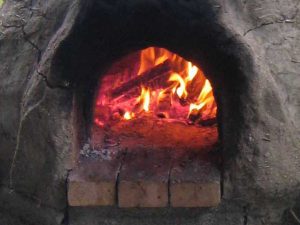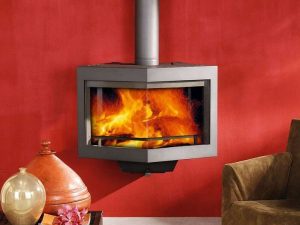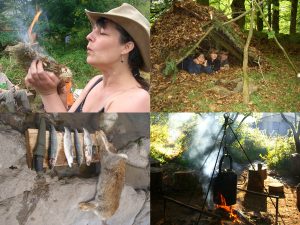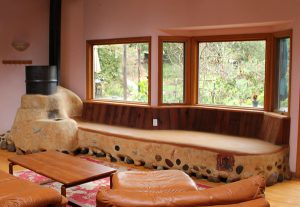Firecraft - introduction
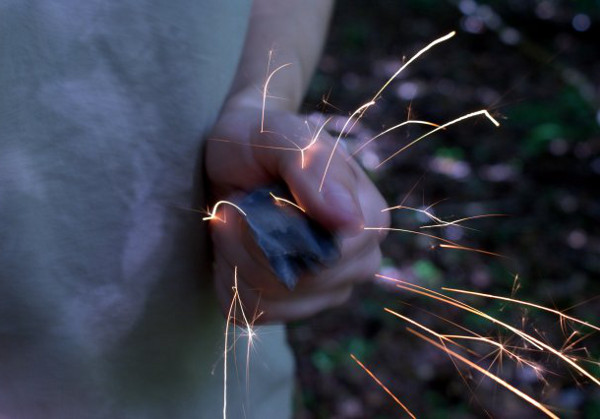
“To catch a fish when you are hungry, cut the boughs of a tree, make a fire to roast it, and eat it in the open air, is the greatest of all luxuries.” – Edmonia Lewis
Contents
What is firecraft?
‘Firecraft’ is about starting and managing fire, usually in a bushcraft setting, but sometimes in a domestic or camping situation. To start a fire requires fuel, oxygen and ignition, and the more natural fire-starting procedures usually progress from a tiny spark to an ember to a flame in very fine, dry material (tinder), to small, thin pieces of wood (kindling) and then to firewood.
Methods
Here are the main ways to start a fire – with the more natural methods first:
- Friction: rubbing things together to create friction that generates heat and produces embers. The best-known example of this is a bow-drill, but any kind of friction will work – for example there is also a fire-plough, which involves moving a hardwood stick back and forth along a groove in a piece of softwood.
- Percussion: striking things together to make sparks – for example flint (or chert) and steel. The sharpness of the flint creates sparks consisting of tiny shards of hot steel when the two are struck together.
- Compression: fire pistons are little cylinders containing a small amount of tinder, with a piston that is pushed hard into the cylinder to compress the air in it, which raises its pressure and temperature enough to ignite the tinder. Fire pistons appeared in the early 19th century in the West, but had been used before then in Asia – usually in cultures that use blowpipes, from which it is believed the fire-piston was developed.
- Light concentration: using a lens or a mirror to focus the sun’s rays to create intense heat in something flammable.
- Fire striker: a manufactured tool that strikes two pieces of (different) metal together to create sparks from the softer of the two metals. This tool is sometimes called a flint lighter, even though it doesn’t contain flint.
- Matches and lighters: too easy to be considered real firecraft, but another way to start a fire nonetheless.

History
Very early humans would have collected embers from fires that had started naturally – forest fires, lightning strikes and even volcanic activity. Archaeological evidence puts the first use of fire between 200,000 and 400,000 years ago – a time that corresponds to a change in human physique consistent with food being cooked. Food was made more easily digestible and nutrients more easily available by cooking, resulting in smaller stomachs and jaws, and greater energy per unit of food consumed.
The first evidence of people starting their own fires is from around 10,000 years ago. A mummified corpse was found in the Alps of a man who lived around 5000 years ago, and had a fire-starting kit consisting of a piece of flint and a piece of iron pyrites – which was used rather than the carbon steel that is used today – plus some pieces of dried fungus known to be used for tinder.

What are the benefits of firecraft?
Environmental
From an environmental perspective, the more natural the method the better. For example, strikers, fire pistons or lenses don’t need fossil fuels or phosphorus, which require the highly-destructive oil and chemical industries, and friction methods don’t require the mining, factories and roads required to manufacture anything at all. Bow-drills / hand-drills can be made from natural materials that are completely biodegradable.
Firewood is a renewable resource (as long as we plant more of it, allow it to regenerate, or, in bushcraft, if we only use dead wood). Firecraft is an essential bushcraft skill, making it easier to spend more time in wild nature – which engenders an understanding and ultimately a love of nature; and people who love nature will want to protect it, which is vital for our survival.
Making fire the natural way is satisfying, fun and makes one feel viscerally connected with nature, and with human history. It’s usually quite a euphoric moment when someone manages to make fire for the first time.
More seriously, firecraft is a basic survival skill. A fire can give heat and light, purify water, allow cooking, keep wild animals away, harden tools and weapons, and produce smoke to preserve food or to reveal your location to potential rescuers. More than this, fire is a boost to morale. Studies have shown that sitting around a fire relaxes us and lowers blood pressure. Even a flame on a screen can do the same thing. Maybe we’ve developed alongside fire for so long that the pleasant experience associated with it is part of our psychological make-up. Sitting around a fire as a group builds community cohesion too.

What can I do?
The more natural methods of fire-making can be tricky, and success is often linked to confidence and practice. Many trainee fire-starters report that lack of confidence that they’re going to succeed in starting a fire is usually a self-fulfilling prophecy. Confidence brings success, and confidence comes from practice. Firecraft is not something you can easily learn from a book – you have to have a go, either by learning from someone with experience, or by attending a course.
Victorian homes often had a tinder-box containing very dry, easily-flammable material (for example, dry grass) for starting a fire. Flint and steel were struck together to cause sparks that fell onto a piece of ‘char cloth’ – a piece of plant-based fabric that had been subjected to pyrolysis (heat in the absence of oxygen) to produce material with a very low ignition temperature that charred and glowed with a tiny ember. This ember was then transferred to the tinder, which ignited and was used to set fire to kindling and then firewood. With practice, this could be done very quickly, and it was a common way to make fire in the home before matches were invented.

People still have wood stoves or open fires in their homes, but this method is extremely rare now that matches and lighters are so easily available. It may return to fashion in situations where matches or fossil fuels are unavailable.
But most firecraft skills are used in the wilds, in bushcraft situations. The most natural way to light a fire is by friction, using a bow-drill (or a hand-drill, which is harder on the hands, but doesn’t require cord, which is hard to make and wears out). This requires a spindle, bow and hearth – all of which you can make yourself, although you can also buy kits from bushcraft shops. The bow is used to turn a spindle rapidly to create friction and heat. The spindle turns in a little bowl in the hearth, which makes dust that gets hot enough to turn into embers that can be introduced to a ‘nest’ of tinder.
If there are two of you, you could do it together, or swap when one gets tired. Kalahari bushmen use a hand-drill that two or three people use together. You need to get practical experience – even the position of your body makes a difference, as you need to maintain enough pressure on the spindle in the bowl whilst turning it rapidly. Use a flat stone or piece of wood to apply pressure to the top of the spindle as it turns. You also need to keep sharpening your spindle. Don’t give up – you’ll get it in the end.
Tinder could be dried grass, some barks (e.g. clematis, or birch, which contains flammable, volatile oils), or some types of fungi, like King Alfred’s cakes. Whichever method you use, the trick is to transfer an ember to a ‘nest’ of tinder, hold it in your hands and blow it or waft it until smoke appears, then keep blowing until it bursts into flame in your hands. Have kindling ready to apply the nest to, and then firewood to add to the lit kindling. A firecraft tip: carry a leather tinder pouch around with you, and when you come across dry material that would make good tinder, pop it in the pouch. Carry the pouch close to you, and the warmth of your body will keep it dry.

The flint and steel method involves a piece of carbon steel (bought from a bushcraft shop or made by a blacksmith) and a piece of flint (found and ‘knapped’ to give a sharp edge, or bought). The steel is usually struck with the flint, although it could be the other way round. Practice until you get the right angle and speed to create a good shower of sparks to ignite your tinder. You may even want to make your own char cloth, by putting some linen or cotton in a small tin with a lid and a hole to allow pressure and smoke to escape. Put the tin in a fire until you see smoke coming out. Take out the tin and you should have some charred cloth that can be used to turn sparks into embers that can be introduced to your tinder.
Flint and steel isn’t a completely natural way to make fire, of course, because although flint is naturally-occurring, carbon steel isn’t. A similar fire-lighting method, but a step further away from natural methods is a (manufactured) ferrocerium rod that can produce sparks when scraped with a knife. Ferrocerium comprises the ‘flint’ in modern lighters, and so the ferrocerium and knife method is actually the same as using a lighter, but on a bigger scale, and with tinder as the fuel rather than butane.

Kindling can be dry twigs or pine cones etc. You should find plenty of dead wood in the wilds for your fire. Tip: if you find wood that’s damp, place it next to the fire to dry out before burning it.
On bushcraft courses, instructors will have insurance and will have done a risk assessment, but in the wild, you’re on your own. Safety is a matter of common sense. Much more care will have to be taken in a dry, forested country in summer (if fires are allowed at all) than in a wet country in winter, for example.
In the UK
There aren’t any regulations covering making a fire outdoors in the UK, apart from the requirement to have the landowner’s permission in England and Wales. In Scotland, you’re allowed to make a campfire anywhere in the wild – probably to do with the fact that Scotland is so wet that a wildfire is extremely unlikely.
Specialist(s)
Thanks to Nigel Berman of School of the Wild for information.
The specialist(s) below will respond to queries on this topic. Please comment in the box at the bottom of the page.

Nigel Berman founded School of the Wild in 2014. He’s spent twenty years creating projects that communicate different ways of seeing the world. He loves sitting round a fire in the woods, and foraging for wild plants. He has a passion for the outdoors, nature connection and ecology, and wants to do something to help fix the broken relationship between people and the planet.

